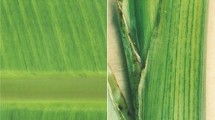Abstract
High-throughput sequencing (HTS) was used to investigate ringspots on ivy (Hedera helix) leaves. De novo assembly of HTS data generated from a total RNA extract from these leaves yielded a contig with sequence similarity to viruses of the genus Badnavirus, family Caulimoviridae. The complete genome sequence of this virus consists of 8,885 nucleotides and has three open reading frames (ORFs). Genome organisation and phylogenetic analysis identifies this newly identified virus as a new member of the genus Badnavirus for which we propose the name "ivy ringspot-associated virus" (IRSaV).


Similar content being viewed by others
References
Bhat A, Hohn T, Selvarajan R (2016) Badnaviruses: the current global scenario. Viruses 8:177. https://doi.org/10.3390/v8060177
Diop SI, Geering ADW, Alfama-Depauw F et al (2018) Tracheophyte genomes keep track of the deep evolution of the Caulimoviridae. Sci Rep 8:1–9. https://doi.org/10.1038/s41598-017-16399-x
Staginnus C, Richertpoggeler K (2006) Endogenous pararetroviruses: two-faced travelers in the plant genome. Trends Plant Sci 11:485–491. https://doi.org/10.1016/j.tplants.2006.08.008
Ruiz-García AB, Bester R, Olmos A, Maree HJ (2019) Bioinformatic tools and genome analysis of Citrus tristeza virus. In: Catara AF, Bar-Joseph M, Licciardello G (eds) Citrus tristeza virus: methods and protocols. Springer, New York, pp 163–178
Sether DM, Melzer MJ, Borth WB, Hu JS (2012) Pineapple bacilliform CO virus: diversity, detection, distribution, and transmission. Plant Dis 96:1798–1804. https://doi.org/10.1094/PDIS-08-11-0718-RE
King AMQ, Lefkowitz E, Adams MJ, Carstens EB (2011) Virus taxonomy: ninth report of the International Committee on Taxonomy of Viruses. Elsevier, New York
Lockhart BEL, Olszewski NE (1996) Schefflera ringspot virus, a widely distributed mealybug-transmitted badnavirus occurring in schefflera and aralia. Acta horticulturae. International Society for Horticultural Science (ISHS), Leuven, pp 196–203
Katoh K, Rozewicki J, Yamada KD (2019) MAFFT online service: multiple sequence alignment, interactive sequence choice and visualization. Brief Bioinform 20:1160–1166. https://doi.org/10.1093/bib/bbx108
Kumar S, Stecher G, Li M et al (2018) MEGA X: molecular evolutionary genetics analysis across computing platforms. Mol Biol Evol 35:1547–1549. https://doi.org/10.1093/molbev/msy096
Felsenstein J (1985) Confidence limits on phylogenies: an approach using the bootstrap. Evolution 39:783–791. https://doi.org/10.1111/j.1558-5646.1985.tb00420.x
Jukes TH, Cantor CR (1969) Evolution of protein molecules. In: Mammalian protein metabolism. Elsevier, New York, pp 21–132
Kitajima EW, Chagas CM, Rodrigues JCV (2003) Brevipalpus-transmitted plant virus and virus-like diseases: cytopathology and some recent cases. Exp Appl Acarol 30:135–160. https://doi.org/10.1023/B:APPA.0000006546.55305.e3
Kitajima EW, Rodrigues JCV, Freitas-Astua J (2010) An annotated list of ornamentals naturally found infected by Brevipalpus mite-transmitted viruses. Sci Agric 67:348–371. https://doi.org/10.1590/S0103-90162010000300014
Author information
Authors and Affiliations
Corresponding author
Ethics declarations
Conflict of interest
All the authors declare they have no conflict of interest.
Ethical approval
This article does not contain any studies with human participants or animals performed by any of the authors.
Additional information
Handling Editor: Elvira Fiallo-Olivé.
Publisher's Note
Springer Nature remains neutral with regard to jurisdictional claims in published maps and institutional affiliations.
Electronic supplementary material
Below is the link to the electronic supplementary material.
Rights and permissions
About this article
Cite this article
Bester, R., Burger, J.T. & Maree, H.J. Genomic characterisation of a newly identified badnavirus infecting ivy (Hedera helix). Arch Virol 165, 1511–1514 (2020). https://doi.org/10.1007/s00705-020-04627-1
Received:
Accepted:
Published:
Issue Date:
DOI: https://doi.org/10.1007/s00705-020-04627-1




